Stamp: Map and Mail Coach (Bulgaria 2020)
Map and Mail Coach (Bulgaria 2020)
29 June (Bulgaria ) within release Europa (C.E.P.T.) 2020 - Ancient Postal Routes goes into circulation Stamp Map and Mail Coach face value 2.30 Bulgarian lev
| Stamp Map and Mail Coach in catalogues | |
|---|---|
| Michel: | Mi: BG 5473A |
Stamp is vertical format.
stamp from souvenir sheetAlso in the issue Europa (C.E.P.T.) 2020 - Ancient Postal Routes:
- Se-tenant - Europa (C.E.P.T.) 2020 - Ancient Postal Routes face value 3.40;
- Stamp - Map and Mail Coach face value 1.10;
- Stamp - Map and Fortress face value 2.30;
- Booklet - Europa (C.E.P.T.) 2020 - Ancient Postal Routes face value 13.60;
- Mini Sheet - Europa (C.E.P.T.) 2020 - Ancient Postal Routes KB face value 13.60;
- Souvenir Sheet - Europa (C.E.P.T.) 2020 - Ancient Postal Routes face value 3.40;
- Stamp - Map and Mail Coach face value 1.10;
- Stamp - Map and Mail Coach face value 1.10;
- Stamp - Map and Mail Coach face value 1.10;
- Stamp - Map and Mail Coach face value 1.10;
- Stamp - Map and Fortress face value 2.30;
- Stamp - Map and Fortress face value 2.30;
- Stamp - Map and Fortress face value 2.30;
- Stamp - Map and Fortress face value 2.30;
- Stamp - Map and Mail Coach face value 1.10;
- Stamp - Map and Mail Coach face value 2.30;
- Stamp with Attached Label - Map and Mail Coach face value 2.30;
- Gutter Pairs - Map and Mail Coach face value 2*2.30;
|
Data entry completed
86%
|
|
|---|---|
| Stamp Map and Mail Coach in digits | |
| Country: | Bulgaria |
| Date: | 2020-06-29 |
| Size: | 32.5 x 43 |
| Perforation: | 13¼ |
| Emission: | Commemorative |
| Format: | Stamp |
| Face Value: | 2.30 Bulgarian lev |
Stamp Map and Mail Coach it reflects the thematic directions:
A fortification (also called a fort, fortress, fastness, or stronghold) is a military construction designed for the defense of territories in warfare, and is used to establish rule in a region during peacetime. The term is derived from Latin fortis ("strong") and facere ("to make").
A map is a symbolic depiction emphasizing relationships between elements of some space, such as objects, regions, or themes. Many maps are static, fixed to paper or some other durable medium, while others are dynamic or interactive. Although most commonly used to depict geography, maps may represent any space, real or imagined, without regard to context or scale, such as in brain mapping, DNA mapping, or computer network topology mapping. The space being mapped may be two dimensional, such as the surface of the earth, three dimensional, such as the interior of the earth, or even more abstract spaces of any dimension, such as arise in modeling phenomena having many independent variables. Although the earliest maps known are of the heavens, geographic maps of territory have a very long tradition and exist from ancient times. The word "map" comes from the medieval Latin Mappa mundi, wherein mappa meant napkin or cloth and mundi the world. Thus, "map" became the shortened term referring to a two-dimensional representation of the surface of the world.
Postal history is the study of postal systems and how they operate and, or, the study of the use of postage stamps and covers and associated postal artifacts illustrating historical episodes in the development of postal systems. The term is attributed to Robson Lowe, a professional philatelist, stamp dealer and stamp auctioneer, who made the first organised study of the subject in the 1930s and described philatelists as "students of science", but postal historians as "students of humanity". More precisely, philatelists describe postal history as the study of rates, routes, markings, and means (of transport).
The mail or post is a system for physically transporting documents and other small packages; or, the postcards, letters, and parcels themselves. A postal service can be private or public, though many governments place restrictions on private systems. Since the mid-19th century national postal systems have generally been established as government monopolies with a fee on the article prepaid. Proof of payment is often in the form of adhesive postage stamps, but postage meters are also used for bulk mailing. Modern private postal systems are typically distinguished from national postal agencies by the names "courier" or "delivery service". Postal authorities often have functions other than transporting letters. In some countries, a postal, telegraph and telephone (PTT) service oversees the postal system, in addition to telephone and telegraph systems. Some countries' postal systems allow for savings accounts and handle applications for passports.



